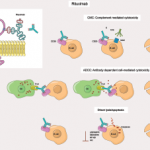The authors note, “One of the strongest predictors of BMI change at six, 12 and 18 months that emerged from this analysis concerned whether the patient had a new diagnosis of AAV or was relapsing at baseline.” Patients newly diagnosed with AAV had an increased mean BMI (± SD) of 0.8 ± 0.3 kg/m2 (P=0.008) compared with patients with relapsing disease. Randomization to rituximab also emerged as a predictor of BMI change at Months 6 and 12. Rituximab-treated patients showed a mean (± SD) increase in BMI at Month 6 of 0.9 ± 0.3 kg/m2 compared with patients randomized to cyclophosphamide (P=0.002).
Researchers were further able to determine that the change in BMI during the first six months of the RAVE trial were associated with disease activity, as reflected by BVAS/WG score, ESR and CRP level.
“In some circumstances, it seems likely that the occurrence of weight gain implies effective disease control,” write the authors in their discussion. “In contrast, the failure of a patient on glucocorticoid treatment to gain weight augurs poorly for long-term disease control. In the absence of effective disease control, the weight loss associated with active disease trumps even glucocorticoid treatment. … It is only when the inflammation associated with AAV has been controlled that the full impact of glucocorticoid treatment on weight gain is realized.”
Although the factors that contribute to weight gain are complex and may be influenced by additional factors, the authors conclude that understanding the “factors mediating the relationship between glucocorticoid exposure and BMI variation is crucial to identifying and defining the significance and potential hazards of weight gain in the treatment of inflammatory conditions.”
Wallace ZS, Miloslavsky EM, Cascino M, et al. Disease activity, glucocorticoid exposure, and rituximab determine body composition changes during induction treatment of ANCA-associated vasculitis. Arthritis Care Res (Hoboken). 2017 Jul;69(7):1004–1010.

